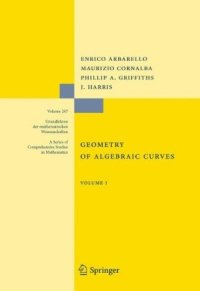
Ebook: Geometry of Algebraic Curves: Volume I
- Genre: Mathematics // Geometry and Topology
- Tags: Algebraic Geometry
- Series: Grundlehren der mathematischen Wissenschaften 267
- Year: 1985
- Publisher: Springer-Verlag New York
- City: New York
- Edition: 1
- Language: English
- djvu
In recent years there has been enormous activity in the theory of algebraic curves. Many long-standing problems have been solved using the general techniques developed in algebraic geometry during the 1950's and 1960's. Additionally, unexpected and deep connections between algebraic curves and differential equations have been uncovered, and these in turn shed light on other classical problems in curve theory. It seems fair to say that the theory of algebraic curves looks completely different now from how it appeared 15 years ago; in particular, our current state of knowledge repre sents a significant advance beyond the legacy left by the classical geometers such as Noether, Castelnuovo, Enriques, and Severi. These books give a presentation of one of the central areas of this recent activity; namely, the study of linear series on both a fixed curve (Volume I) and on a variable curve (Volume II). Our goal is to give a comprehensive and self-contained account of the extrinsic geometry of algebraic curves, which in our opinion constitutes the main geometric core of the recent advances in curve theory. Along the way we shall, of course, discuss appli cations of the theory of linear series to a number of classical topics (e.g., the geometry of the Riemann theta divisor) as well as to some of the current research (e.g., the Kodaira dimension of the moduli space of curves).
The second volume of the Geometry of Algebraic Curves is devoted to the foundations of the theory of moduli of algebraic curves. Its authors are research mathematicians who have actively participated in the development of the Geometry of Algebraic Curves. The subject is an extremely fertile and active one, both within the mathematical community and at the interface with the theoretical physics community. The approach is unique in its blending of algebro-geometric, complex analytic and topological/combinatorial methods. It treats important topics such as Teichm?ller theory, the cellular decomposition of moduli and its consequences and the Witten conjecture. The careful and comprehensive presentation of the material is of value to students who wish to learn the subject and to experts as a reference source.
The first volume appeared 1985 as vol. 267 of the same series.